Best Motherboard for Ryzen 7 3800x: Complete Reviews With Comparisons

Ryzen designed the 7-3700x processor for competition-class gaming and everything else that needs the same computing power.
However, the 7-3700x needs a good pairing of components to work well in the long haul.
One of the most critical decisions you will have to make is choosing the correct motherboard.
The best motherboards for Ryzen 7 3800x can be ones with the X570 chipset, and they could also be one of the top B550 motherboards.
To make the decision lighter on your part, we came up with a list of five outstanding options.
Comparison Chart
Motherboard for Ryzen 7 3800x Reviews
1. ASUS Prime X570-Pro
The ASUS Prime X570-Pro is an ATX motherboard designed for prosumers looking for quality performance at a slightly friendly price.
It lacks some components that it should already have at its price point, but it focuses on features that matter most.
ALSO READ:
Motherboard for Ryzen 7 5800x
Review
The Prime X570-Pro features a sleek and minimalist board design with its black PCB and white heatsinks.
For added aesthetics, you will even find some RGB lighting on the primary heat dissipators.
The board is capable of hosting four 32GB memory modules for a maximum RAM capacity of 128GB.
Overclocking speeds can go as fast as 4400MHz, but we found some tweaking problems with the bundled software.
The good thing is you can always rely on ASUS to bring the firmware up to speed.
- Expansion and Storage
For expansion, the board has the most PCIe 4.0 x16 sockets among the options and all support PCIe 3.0 connections.
Additionally, you will find three PCIe 4.0 x1 slots.
You can use these expansion sockets for multiple GPUs employing NVIDIA 2-Way SLI, AMD 3-Way CrossFireX, or AMD 2-Way CrossFireX.
This versatile feature makes the board an excellent choice for content creators and gaming enthusiasts.
The storage interface includes six SATA 6Gbps sockets and two M.2 slots, a combination that is pretty common for most ATX motherboards.
- Built-in Connectors
Coursing through the rear panel is an integrated IO shield that protects all the connectors from power surges and static disturbances.
It has an Intel Gigabit LAN controller, but it does not include a wireless module.
You’re probably better off using one of the expansion slots for a wireless controller if you need Wi-Fi.
Audio and display connectors are on point with a DisplayPort, an HDMI, five premium audio jacks, and an optical S/PDIF out port.
It’s a bit vague why ASUS removes USB 2.0 from this board when it still has a PS/2 combo port.
The USBs include four USB 3.2 Gen1 and four USB 3.2 Gen2. One of the Gen2 ports is a Type-C.
You can have seven more USB ports if you use the internal headers.
PROS
CONS
2. ASUS ROG Crosshair VIII Dark Hero
The Crosshair VIII Dark Hero is a flagship ATX motherboard from the ASUS ROG lineup.
While it can easily max out the capabilities of the 7-3800x, it offers extensive future-proofing for much better CPUs.
Also, its price tag may be too much for most entry-level PC builders. Even so, it is a bargain compared to other flagship X570 boards.
Review
With its all-black design, the Crosshair VIII Dark Hero goes dark, but it features plenty of options for RGB lighting.
One of its primary selling points is its 16-phase, 90-ampere power delivery. In comparison, other options only offer 60 amperes.
The Dark Hero can overclock RAM up to 5100MHz, especially if you fill each of its four DDR4 DIMM slots with 32GB modules.
- Expansion and Storage
ASUS fits this board with three full-sized expansion sockets and a single PCIe 4.0 x1 slot.
All x16 sockets support PCIe 4.0 devices, but you can also use any compatible PCIe 3.0 device.
Multi-graphics support is interchangeable between NVIDIA 2-Way SLI, AMD 3-Way CrossFireX, or AMD 2-Way CrossFireX.
While this flagship motherboard only carries two M.2 slots for storage, it boasts eight SATA 6Gbps ports.
- Built-in Connectors
Since the flagship Dark Hero expects you to use at least one compatible GPU, it does not have any display connectors on the rear panel.
Instead, ASUS fits it with four USB 3.2 Gen1 ports and eight USB 3.2 Gen2 ports. One of the Gen2 ports is a Type-C.
As if those USB ports weren’t enough, you can have seven more through internal routing.
The Dark Hero will not give you network connectivity headaches unless you have internet connection problems.
It boasts two LAN modules and a dual-band Intel Wi-Fi 6 AX200.
Other connectivity features include five premium gold-plated audio jacks and an optical S/PDIF out port.
Plus, the rear panel has a Clear CMOS button and a BIOS Flashback button as add-ons.
PROS
CONS
3. Gigabyte X570 Aorus Master
Like the Dark Hero, the Gigabyte X570 Aorus Master is a flagship ATX motherboard.
It sits at the higher end of the spectrum, with some significant improvements to board design here and there.
For this very reason, it comes with a price tag that can be hefty for those on a budget.
Nevertheless, you’ll still find that it costs much cheaper than the Dark Hero.
Review
The X570 Aorus Master has an all-improved appearance that stems from previous offerings of the Aorus product line.
Heatsinks wrap around the primary connectors, with some RGB lighting features near the VRMs.
It has an upgraded power solution and a passive and silent thermal design that perfectly handles fast and heavy workloads.
Memory capacities are the same at 128GB, but overclocking frequencies only reach 4400MHz.
- Expansion and Storage
For expansion, the Aorus Master has three full-sized, fully-reinforced sockets.
Only the first x16 expansion socket can hold a PCIe 4.0 device. Plus, a fourth expansion slot runs in PCIe 4.0 x1 mode.
This motherboard offers versatility in multi-GPU attachments.
You can use devices that support Quad-GPU and 2-Way attachments using NVIDIA SLI or AMD CrossFire.
Everything is pretty standard in the storage department for the Aorus Master.
It does away with only six SATA 6Gbps ports, unlike the Dark Hero, which has eight.
If you need M.2 storage devices, this board also has two M.2 slots.
- Built-in Connectors
While the Dark Hero has 12 high-speed USBs, the Aorus Master only has 10, and four of them are USB 2.0.
The other ports include two USB 3.2 Gen1, three USB 3.2 Gen2 Type-A, and one USB 3.2 Gen2 Type-C.
If you need more USBs, internal connectors will allow nine more.
Network connectivity features for the Aorus Master are comparable with the Dark Hero.
The rear panel has two LAN ports as well as the latest in Wi-Fi 6 dual-band antenna connectors.
You will also find premium audio components on this board, including five audio jacks and an optical S/PDIF out port.
Keep in mind that since it doesn’t have any display connectors, this board expects you to use a GPU.
Similar extra features include a Q-Flash Plus button and a Clear CMOS button.
PROS
CONS
4. MSI MAG B550 Tomahawk
If you think the previous options are too fancy for your taste, check out the MSI MAG B550 Tomahawk.
It is an ATX motherboard, but you’ll appreciate that it doesn’t break the bank.
Furthermore, it can stand out as a good pairing for the 7-3800x with some performance tweaking.
Review
Among the options, the MAG B550 Tomahawk has the most basic board design.
It focuses the heatsinks around the PCH, VRMs, and rear panel, and it adds some flair by putting some lights around the chipset.
The MAG B550 Tomahawk boasts an overclocked memory frequency of 5100MHz, just like the Dark Hero.
However, memory and CPU overclocking can be a bit topsy-turvy with this motherboard.
Because of this, you might need some practice before you can actually get there.
Then again, we all know that ASUS provides the more user-friendly approach to overclocking.
Nevertheless, this board keeps up with the maximum system RAM capacity of 128GB.
- Expansion and Storage
One of the reasons why the MAG B550 Tomahawk is cheaper is its fewer full-sized expansion sockets.
It only has two x16 slots, and only one of them can support PCIe 4.0 devices.
Still, the board compensates by adding two PCIe 3.0 x1 slots.
This setup only allows multi-graphics configurations using the 2-Way AMD CrossFire Technology.
The MAG B550 Tomahawk is way more affordable than the Aorus Master.
Yet, you’ll find that it has the same number of storage interface ports.
- Built-in Connectors
You can use this motherboard without a GPU because it has an HDMI port and a DisplayPort.
Other rear panel connectors include a PS/2 combo port, two USB 2.0, two USB 3.2 Gen1, one USB 3.2 Gen2 Type-A, and one Type-C.
In addition, MSI does not hold back on audio features on this board.
You’d be able to enjoy five audio jacks as well as an optical S/PDIF out port.
Finally, it features two RJ45 LAN ports, but it does not have a built-in wireless adapter.
PROS
CONS
5. MSI MPG X570 Gaming Edge Wi-Fi
We’re including the MPG X570 Gaming Edge Wi-Fi to give you a better option from MSI.
It is also an ATX motherboard, and it has better features than the MAG B550 Tomahawk.
An excellent point to consider is that this board only costs a few bucks more than the Tomahawk.
RELATED:
Motherboard for Ryzen 7 3700X (Guide)
Review
The MPG X570 Gaming Edge is an attractive all-black motherboard with massive heatsinks and some RGB backlighting.
It has an actively cooled PCH to complement the chipset and M.2 heatsink. However, it only has five fan headers.
Because of this, you might want to be careful when overclocking by avoiding excessive overheating of the components.
This board has a maximum RAM capacity of 128GB, but it only allows overclocked memory frequencies up to 4400MHz.
- Expansion and Storage
Like the MAG B550 Tomahawk, the MPG X570 Gaming Edge only has two full-sized expansion sockets.
This board’s advantage, however, is that both x16 sockets support PCIe 4.0 devices.
Additionally, the Gaming Edge has three PCIe 3.0 x1 slots. Multi-graphics support is also limited to 2-Way AMD CrossFire.
For storage, this board features the standard ATX capacity of six SATA 6Gbps ports and two M.2 slots.
- Built-in Connectors
Moving to the rear panel, the Gaming Edge offers a good mix of connectivity features.
It has an HDMI port and high-quality audio components consisting of five gold-plated audio jacks and an optical S/PDIF out port.
You will also find dual Wi-Fi antenna connectors and an RJ45 LAN port for network connections.
For peripheral devices, the board features a PS/2 combo port and eight USB ports.
The eight USB ports include two USB 2.0, two USB 3.2 Gen1, three USB 3.2 Gen2 Type-A, and one USB 3.2 Gen2 Type-C.
As an extra feature, a Flash BIOS button sits beside the two USB 2.0 ports.
PROS
CONS
Final Verdict
After going over the details, the ASUS ROG Crosshair VIII Dark Hero is obviously the top motherboard for Ryzen 7 3800x.
The problem is, it can be very costly for most entry-level consumers.
If you are on a budget, the best board for you is the MSI MPG X570 Gaming Edge Wi-Fi.
For professional content creators, the best buy is the ASUS Prime X570-Pro.
Otherwise, if you think that the X570 or B550 platforms are a bit overkill for your taste, you can choose from the best B450 motherboards instead.














